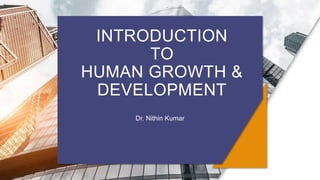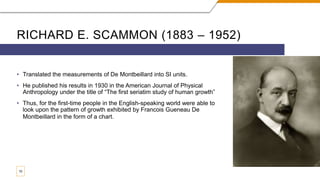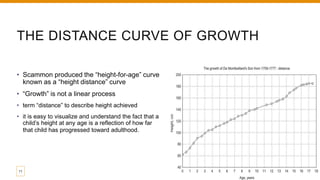intro to human growth and development.pptx
- 1. INTRODUCTION TO HUMAN GROWTH & DEVELOPMENT Dr. Nithin Kumar
- 2. INTRODUCTION ŌĆó Human growth and development are characterized and defined by the way in which we change in size, shape, and maturity relative to the passage of time. ŌĆó It has been more common for the size of children to be assessed for reasons of classification and organization that requires assessment at certain ages for specific reasons. ŌĆó However, the first longitudinal record we have of the growth of a child was the result of a desire to apply scientific method to the natural world. Patterns of Human Growth 2
- 3. GROWTH ŌĆō DEFINITION ŌĆó It is the process of physical maturation resulting an increase in size of the body and various organs. ŌĆó It occurs by multiplication of cells and an increase in in intracellular substance. ŌĆó It is quantitative changes of the body. 3
- 4. DEVELOPMENT ŌĆō DEFINITION ŌĆó It is the process of functional and physiological maturation of the individual. It is progressive increase in skill and capacity to function. ŌĆó It is related to maturation and myelination of the nervous system. ŌĆó It includes psychological, emotional and social changes. ŌĆó It is qualitative aspects. 4
- 5. HISTORICAL BACKGROUND 5 How it all ▓·▒▓Ą▓╣▓įŌĆ”
- 6. ŌĆ£AGE OF ENLIGHTENMENTŌĆØ ŌĆó in 18th century France, Between the death of Louis XIV & emergence of Napoleon Bonaparte (1715- 1799) ŌĆó a movement away from religious and monarchical authority and toward a more liberal and empirical attitude. ŌĆó natural scientists and philosophers believed that peopleŌĆÖs habits of thought were based on irrationality, polluted by religious dogma, superstition, and over- adherence to historical precedent and irrelevant tradition. ŌĆó The way to escape from this is to seek for true knowledge in every sphere of life, to establish the truth and build on it, thereby literally ŌĆ£enlighteningŌĆØ PeopleŌĆÖs minds 6
- 7. GEORGES-LOUIS LECLERC(COMPTE DE BUFFON (1707 ŌĆō 88) ŌĆó interested in mathematics, natural science, and silviculture, the cultivation of trees. ŌĆó premier horticulturist and arborist in France and was appointed by King Louize XVth as the director of the Jardin du Roi ŌĆó king invited him to write a compendium on the herbs of France ŌĆó But Buffon decided such a compendium would be too narrow and instead started working on a broader project that was to include all that was known of natural history. - ŌĆ£Histoire Naturelle, Ge┬┤ne┬┤rale et Particulie`reŌĆØ ŌĆó Ending up with 36 volumes by the time of his death in 1788 ŌĆó This included 15 volumes on quadrupeds, 9 on birds, 5 on minerals and 7 ŌĆ£Supplementary Volumes. 7
- 8. BERNARD GERMAIN DE LAPEAUDE ŌĆó appointed as a sub-demonstrator in the Jardin in 1785 ŌĆó further added 8 volumes to ŌĆ£Histoire Naturelle, Ge┬┤ne┬┤rale et Particulie`reŌĆØ ŌĆó These 8 volumes included 2 on reptiles, 5 on fish, and 1 on Cetacea. ŌĆó However, it is the supplement to volume 14, published in 1778, that is particularly interesting to us. ŌĆó As it contained record of the growth of a boy, Francois Gueneau De Montbeillard (1759-1847). 8
- 9. PHILIBERT GUENEAU DE MONTBEILLARD (1720 ŌĆō 85) ŌĆó He would take an empirical interest in the growth of his own son ŌĆó had been measuring the height of Francois about every 6 months from his birth until he was 18 years of age. ŌĆó Was a close friend of Buffon and their common interest in the natural sciences resulted in De Montbeillard being invited as a co-author ŌĆó Buffon wished to include this primary evidence of the course of human growth ŌĆó 9
- 10. RICHARD E. SCAMMON (1883 ŌĆō 1952) ŌĆó Translated the measurements of De Montbeillard into SI units. ŌĆó He published his results in 1930 in the American Journal of Physical Anthropology under the title of ŌĆ£The first seriatim study of human growthŌĆØ ŌĆó Thus, for the first-time people in the English-speaking world were able to look upon the pattern of growth exhibited by Francois Gueneau De Montbeillard in the form of a chart. 10
- 11. THE DISTANCE CURVE OF GROWTH ŌĆó Scammon produced the ŌĆ£height-for-ageŌĆØ curve known as a ŌĆ£height distanceŌĆØ curve ŌĆó ŌĆ£GrowthŌĆØ is not a linear process ŌĆó term ŌĆ£distanceŌĆØ to describe height achieved ŌĆó it is easy to visualize and understand the fact that a childŌĆÖs height at any age is a reflection of how far that child has progressed toward adulthood. 11
- 12. THE DISTANCE CURVE OF GROWTH 1. growth is a continuous process. 2. growth is not a linear process i. e., we do not gain the same amount of height during each calendar year. 3. this growth curve has five distinct phases corresponding to ŌĆó relatively rapid growth in infancy ŌĆó steady growth in childhood ŌĆó a short period of rapid growth during the juvenile period ŌĆó a second period of rapid growth during adolescence ŌĆó very slow growth as the individual nears adulthood. 4. growth represents a most dramatic increase in size. Eg: Francois De Montbeillard grew from about 50 cm at birth to over 186 cm at adulthood. 5. we stop growing and reach our adult height, during our late teenage years. Observation from distance curve of growth 12
- 13. THE DISTANCE CURVE OF GROWTH ŌĆó The fact that this growth curve shows constant pattern eg: polynominal, sigmoidal, allows us to apply mathematical ŌĆ£modelsŌĆØ to the pattern of growth. ŌĆó These models are, in fact, parametric functions that contain constants or ŌĆ£parameters.ŌĆØ ŌĆó Once we have found an appropriate function that fits the raw data, we can analyze the parameters and by so doing learn a good deal about the biological process responsible for growth. ŌĆó Consequently, they can be used in research into human growth. 13
- 14. VELOCITY GROWTH CURVE & GROWTH SPURTS
- 15. ŌĆó The rate of change of size with time is called ŌĆ£growth velocityŌĆØ ŌĆó DŌĆÖArcy Thompson a famous British natural scientist & mathematical biologist published a book titled ŌĆ£On Growth and FormŌĆØ in 1917 ŌĆó He wrote, ŌĆ£An organism is so complex a thing, and growth so complex a phenomenon, that for growth to be so uniform and constant in all the parts as to keep the whole shape unchanged would indeed be an unlikely and an unusual circumstance. Rates vary, proportions change, and the whole configuration alters accordingly.ŌĆØ ŌĆó While the distance curve, ŌĆ£showed a continuous succession of varying magnitudes,ŌĆØ the curve of the rate of change of height with time, ŌĆ£shows a succession of varying velocities. 15
- 16. 16
- 17. ŌĆó Distinct increase in growth rate or growth velocity is termed ŌĆ£growth spurtŌĆØ ŌĆó Following birth, two relatively distinct increases in growth rate occur ŌĆó at 6-8 years ’āĀ juvenile or mid-growth spurt ŌĆó at 11-18 years ’āĀadolescent growth spurt 17
- 18. ŌĆó Another growth spurt occurs prior to birth between 20 and 30 weeks of gestation ŌĆó There is increase in height as well as weight ŌĆó Observed through intra-uterine ultrasound measurements of fetuses and extra- uterine anthropometric measurements of pre-term infants ŌĆó Corresponds to rapid accumulation of fat during this period. ŌĆó Why?? Fat is a more efficient source of energy than protein or carbohydrate ŌĆó This significant source of energy is required by the infant during immediate post-natal period 18
- 19. ŌĆó Pre-natal spurt and juvenile growth spurt may vary in magnitude, but they seem to occur at similar ages both within and between the sexes. ŌĆó Adolescent growth spurt demonstrates sexual dimorphism in both magnitude and timing ŌĆó Males enter their adolescent growth spurt almost two years later than females ŌĆó Changes includes extra height, muscle mass and fat distribution ŌĆó Males demonstrate rapid increases in muscle mass and females accumulate greater amounts of fat. 19
- 21. OTHER PATTERNS OF GROWTH ŌĆó Pattern of growth in height is only one of several patterns of growth that are found within the body ŌĆó Neural tissue (brain and head), lymphoid tissue (thymus, lymph nodes, intestinal lymph masses), reproductive tissue (testes, ovaries, epididymis, prostate, seminal vesicles, Fallopian tubes) as well as some major organ systems (respiratory, digestive, urinary). ŌĆó Research on the growth of neural tissue must be targeted at fetal and infant ages ŌĆó Research on the growth of reproductive tissue on adolescent or teenage years when growth is at a maximum. 21
- 23. ŌĆó ŌĆ£GrowthŌĆØ is defined as an increase in size while ŌĆ£maturityŌĆØ or ŌĆ£developmentŌĆØ is an increase in functional ability. ŌĆó All children who live in normal environmental circumstances will have a similar pattern of growth. ŌĆó Getting taller, heavier, fatter, and more muscular as well as changes in our body proportions till we reach adulthood. ŌĆó We become more ŌĆ£matureŌĆØ, when we experience an increase in our functional capacity with advancing age with increasing ability to undertake physical exercise in terms of both magnitude and duration 23
- 24. ŌĆó The figure shows three boys and three girls who are of the same ages within sex. ŌĆó Even though they are the same age they demonstrate vastly different degrees of maturity. ŌĆó The boy and girl on the left are relatively immature compared to those on the right as depicted by their indicators of maturity or ŌĆ£maturity indicatorsŌĆØ ŌĆó There is obvious development of secondary sexual characteristics (breast and pubic hair in girls and genitalia and pubic hair in boys), in addition to dramatic changes in body shape, increases in muscularity in males and increases in body fat in females 24
- 25. ŌĆó The end-point of growth is the size we attain by adulthood ŌĆó The end-point of maturity is when we are functionally able to successfully procreate. ŌĆó Not simply to be able to produce a viable sperm or egg, but to produce an offspring who themselves may also procreate ŌĆó Thus, successful maturation requires not just biological maturity but also psycho-social and behavioral maturity. 25
- 26. ŌĆó Because size is governed by factors other than the process of maturation, we cannot use an absolute size to determine maturation. ŌĆó Use the appearance and relative size of structures rather than their absolute size to reflect maturity. ŌĆó Also, use of various maturity indicators are secondary sexual development, skeletal maturity, and dental maturity 26
- 28. ŌĆó Growth and development is both complex and extensive. ŌĆó Genetic, epigenetic, and environmental factors has an influence ŌĆó Environment has the potential to alter genetic blueprint we are born with affecting our ability to achieving a particular adult size and shape. ŌĆó This environmental factor will affect primarily the endocrine system ŌĆó 28
- 29. ŌĆó The anterior lobe or ŌĆ£adenohypophysisŌĆØ of pituitary gland releases the major hormones controlling human growth and development; growth hormone, thyroid stimulating hormone, prolactin, the gonadotrophins (luteinizing and follicle stimulating hormone), and adrenocorticotropic hormone ŌĆó Normal growth is a result of a complex and at times exquisite relationship between the nervous and endocrine systems. ŌĆó Growth hormone ’āĀ release of insulin-like growth factor 1 (IGF-1) from the liver. 29
- 30. ŌĆó IGF-1 directly affects skeletal muscle fibers and cartilage cells in the long bones to increase the rate of uptake of amino acids and incorporate them into new proteins and thus contributes to growth in length during infancy and childhood. ŌĆó At adolescence, the gonadal hormones or sex steroids (testosterone in boys, and estrogen in girls) affects the growth spurt ŌĆó Hence, diagnosis of growth disorders becomes a complex and engrossing series of investigations that increasingly requires an appreciation of both genetic, environmental and endocrine mechanisms. 30
- 32. ŌĆó In order to assess the normality or otherwise of the growth of children we use ŌĆ£growth reference charts.ŌĆØ ŌĆó These charts depict both the average height to be expected throughout the growing years (typically from birth to 18 years), and the range of normal heights, in the form of percentile or ŌĆ£centileŌĆØ distributions 32
- 33. CANALIZATION
- 34. ŌĆó Growth of children without any environmental constrain exhibits a pattern more or less parallel to a particular centile or within some imaginary ŌĆ£canal.ŌĆØ ŌĆó This phenomenon is termed ŌĆ£canalizationŌĆØ or ŌĆ£homeorrhesis.ŌĆØ ŌĆó This pattern is genetically determined ŌĆó This genetic potential for adult stature and the process of growth, in an unconstrained environment, takes us inevitably toward that target. 34
- 35. CATCH-UP GROWTH
- 36. 36
- 37. ŌĆó Waddington equates growth to the movement of a ball rolling down a valley floor. ŌĆó The sides of the valley keep the ball rolling steadily down the central course (point A). ŌĆó If an insult occurs, it tends to push the ball out of its groove or canal and force it up the side of the valley (point B) ŌĆó The magnitude of the loss of velocity will depend on the severity and duration of the insult. ŌĆó Alleviation of the insult will result in a rapid return to the valley floor at an increased velocity (point C) ŌĆó Having reached the floor normal growth velocity is resumed (point D) 37
- 38. 38 ŌĆó Growth chart of a girl who has suffered from celiac syndrome. ŌĆó Condition there is an abnormality of the lining of the gut and food cannot be absorbed ŌĆó Malnourished ’āĀ growth retardation ŌĆó On diagnosis the child is switched to a gluten-free diet which alleviates the malabsorption. ŌĆó Rapid recovery of height velocity ŌĆó She demonstrates ŌĆ£completeŌĆØ catch-up growth within 1-2 years.
- 40. ŌĆó Introduction to the study of human growth and development. ŌĆó Curve of human growth has been changing as we evolve ŌĆó There is less of environmental constrains on us now, but it is still there ŌĆó Infancy and adolescence are the two major stages where adjustment to final size and shape is still occurring ŌĆó More than 50% of infants exhibit either catch-up or catch-down growth, which has direct bearing on the final size, shape, morbidity, and perhaps mortality ŌĆó Timing of the adolescent growth spurt is also important in terms of healthy and successful survival. 40
- 41. ŌĆó We are the survivors and use various survival strategies to survive and propagate our species. ŌĆó One of the most powerful of these strategies is the plasticity of our growth and development. ŌĆó In subsequent chapters you will learn how that plasticity is inherited, controlled, and expressed ŌĆó It is a fascinating story about the most fundamental biological phenomena of our species. 41
- 42. 42


































































































